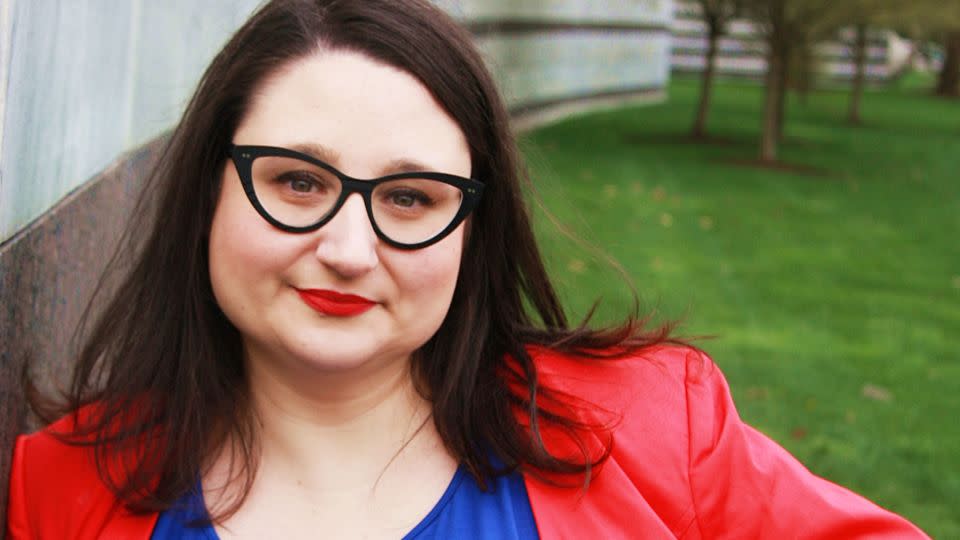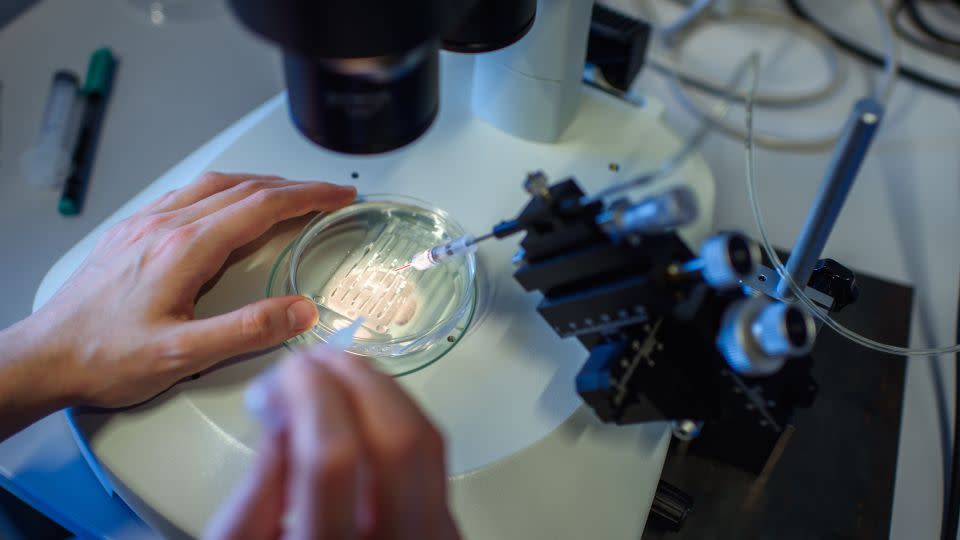Opinion: The revolutionary sickle cell therapies
Editor’s Note: Elizabeth Yuko, Ph.D., is a bioethicist and writer whose work has appeared in The New York Times, Rolling Stone, The Washington Post, The Atlantic and elsewhere. She is also an adjunct professor at Fordham University. The views expressed here are hers. Read more opinion on CNN.
In December, the US Food and Drug Administration (FDA) approved the first two cell-based gene therapies for treating sickle cell disease (SCD) in people ages 12 and older: Casgevy and Lyfgenia. Since then, questions and concerns have abounded about the cost and accessibility of these treatments — including from Health and Human Services Secretary Xavier Becerra, who has consistently highlighted the financial barriers standing between people living with SCD and these new gene therapies.

While both Casgevy and Lyfgenia are breakthroughs, Casgevy is important for one more reason: It’s the first FDA-cleared clinical use of CRISPR-Cas9 (commonly just referred to as CRISPR) gene editing for the treatment of any condition. (Though Lyfgenia also relies on gene modification, it uses different, better-established technology.)
Gene editing refers to various methods that can be used to introduce, replace or remove DNA sequences in the genomes of organisms — including humans. CRISPR acts like genetic scissors to cut and then edit DNA in a particular spot, and has gained favor among researchers for being easier, faster, more accurate and less expensive than earlier techniques.
This first FDA-approved therapeutic application of CRISPR is, without question, a significant step forward in the field of gene therapy and the practice of medicine. And, like any emerging medical technology, the initial use of the innovative gene editing tool has been met with an amalgam of anticipation and anxiety.
To be sure, there are ethical issues at play — most notably, questions of accessibility of the new multimillion-dollar treatments. But as the gene editing tool becomes part of the toolkit for treating an increasing number of conditions, it’s important not to conflate or even associate this application of CRISPR with more problematic uses of the technology.
Casgevy and Lyfgenia are long overdue
The group of inherited red blood cell disorders collectively known as SCD is characterized by abnormalities that make a person’s red blood cells sticky and C-shaped instead of round. These sickle cells cause blockages in a patient’s blood vessels, often resulting in pain and other complications.
The US Centers for Disease Control and Prevention estimates that it affects approximately 100,000 people in the United States. SCD is most prevalent among those with African ancestry, according to the National Heart, Lung, and Blood Institute. A study published in May 2023 indicates that of the nearly 75,000 people hospitalized for SCD in the United States between 2016 and 2018, 93% were Black. In the US, about 20,000 people are thought to have a form of the disease severe enough to potentially qualify for these gene-based treatments.
About 20% of SCD patients in the United States have a more severe form of the disease, characterized by frequent, painful episodes, estimates Dr. David A. Williams, the chief of hematology/oncology at Boston Children’s Hospital and a professor of pediatrics at Harvard Medical School. Williams wasn’t involved in the clinical trials for either of the new gene therapies, but consulted on the regulatory approval process for both manufacturers.
“It’s analogous to the pain that you get with a heart attack — which people often express is the most excruciating pain they’ve ever felt,” he tells me. The recurrence and unpredictability of these agonizing episodes impact virtually every aspect of a person’s life, which can make it difficult to go to school consistently or hold down a job.
Yet, despite its debilitating effects — and the fact that in 1949, SCD became the first disease identified on a molecular level — research into treatments and cures remained underfunded for decades. This was, in large part, the result of what Harriet A. Washington describes in her book Medical Apartheid, as the “erroneous belief” that SCD “was a racial condition that only struck African Americans.”
While there are four drugs used to treat aspects of SCD — three of which were approved between 2017 and 2019 — the only potential cure for the condition has been a stem cell transplant.
Transplants from matched sibling donors have the best chance of success, but, as Williams points out, it’s estimated that fewer than 20% of SCD patients have suitable sibling donors. Though it’s also possible to use stem cells from someone who isn’t related to the recipient, Williams says that “the number of available donors that match a person of African American ancestry or Latinx ancestry is low” and doesn’t meet the demand.
Enter the two newly approved treatments. Though they both involve transplants, a patient’s own stem cells are used — eliminating the need for a donor and the accompanying risks.
While Casgevy uses CRISPR to edit DNA in a patient’s blood stem cells so that they start producing healthy hemoglobin, Lyfgenia uses components from a virus to deliver a new gene to a patient’s blood stem cells that produces healthy hemoglobin.
Having two innovative therapies to treat a disease that affects a chronically underserved demographic is major, overwhelmingly positive news.
CRISPR complicates the conversation
The laser focus on CRISPR has, in many ways, overshadowed the introduction of the long-overdue SCD treatments. Though the FDA’s inaugural approval of a treatment that uses the gene editing tool is, of course, noteworthy, the emphasis placed on CRISPR — which many people understand to have at least some ethically problematic applications — could cast an undeserved shadow over the new therapies.
The confusion often stems from the fact that CRISPR can be used to edit two different categories of cells: germ cells (eggs and sperm), and somatic cells, which make up the rest of the body — including the blood cells Casgevy alters. Editing somatic cells only affects the individual; on the contrary, any changes made to the genetic material of embryos or germ cells are passed on to subsequent generations.

Because of the ethical questions raised when genetic modifications impact not only the patient, but their descendants as well, germline modification has, understandably, received the bulk of the public’s attention where CRISPR is concerned. And to be clear, that use of the “genetic scissors” is unrelated to their use in Casgevy.
“There’s little controversy over somatic cell gene editing: We’ve been doing that now for many years,” says Williams. “That’s very much in contrast to germ cell gene editing, which is banned.”
The high cost of treatment
At this point, it’s unclear how much SCD patients will have to pay for the treatments, and whether insurance companies will cover either. What we do know is that the manufacturers will sell Casgevy and Lyfgenia to wholesalers in the US — which sell products to pharmacies and medical facilities at a markup — for $2.2 million and $3.1 million, respectively.
The US Department of Health and Human Services recently announced that it will introduce a new pricing model in 2025 making Casgevy and Lyfgenia more accessible to the estimated 50% to 60% of people living with SCD enrolled in Medicaid. The release — which also notes that “hospitalizations and other health episodes related to SCD cost the health system almost $3 billion per year” — does not mention anything about making the new therapies affordable for SCD patients who aren’t enrolled in Medicaid. (Recent reporting from KFF suggests that Blue Cross Blue Shield will cover these therapies, though the out-of-pocket cost for patients could still be high.)
Bluebird bio, the maker of Lyfgenia has noted that the price is “in recognition of the value the therapy may deliver through robust and sustained clinical benefits” and the impact that the treatment could have on reducing the healthcare cost of dealing with the disease over the course of a patient’s lifetime. Both companies have estimated the cost of managing SCD to be between $4 million and $6 million over the lifetime of a patient with recurrent pain crises.
The excessively high costs of the new treatments would make them inaccessible to many patients in the US, and even further out of reach for people living in low- and middle-income countries where SCD is much more common.
This is unjust not only because people living in one part of the world aren’t more deserving of treatment than others, but also because it would likely exacerbate existing health disparities — essentially limiting SCD to people with lower incomes.
Weighing risks and benefits
Like any newly approved treatment or procedure, the long-term outcomes of Casgevy and Lyfgenia — including whether they’ll be lifetime cures for SCD, as anticipated — aren’t yet known. While Lyfgenia utilizes a gene therapy technique that’s been used in patients with various genetic disorders since the 2010s, Dr. Punam Malik, director of the Sickle Cell Center at Cincinnati Children’s, says the CRISPR gene editing approach used in Casgevy is limited to two to three years of clinical experience.
At this point, however, only Lyfgenia carries a black box warning from the FDA: the result of two participants in an earlier iteration of Lyfgenia’s clinical trial dying after being diagnosed with leukemia. (The makers of the drug suggested these deaths were not likely related to the gene therapy but may have been linked to the chemotherapy participants needed to prepare for it.)
While no serious adverse events were reported during the Casgevy clinical trials, Williams says that it’s not yet known whether CRISPR gene editing in general takes place only where directed, or if it occurs elsewhere in the genome as well. If this “off target” editing takes place, it likely doesn’t occur frequently, as the FDA hasn’t flagged it as a concern.
Opening the door to future CRISPR therapies
The fact that the first FDA-approved application of CRISPR gene editing is a treatment for SCD wasn’t intended to be a gesture attempting to make up for more than a century of ignoring the condition and patient population. Nonetheless, Williams says “it’s great that it’s happened.”
After the first treatment using CRISPR was granted FDA approval, Williams predicted that the gene editing system would be “applied to other diseases fairly quickly.” And that has indeed been the case; Not long after, the FDA cleared the use of a CRISPR treatment for a second disease: beta thalassemia.
What’s more, preliminary research suggests that therapies using CRISPR-based gene editing may have the potential to treat other life-altering hereditary diseases, like Alzheimer’s, Parkinson’s, Huntington’s and cystic fibrosis.
In the meantime, the focus should be on making Casgevy and Lyfgenia — as well as the next generation of SCD gene therapies — more affordable to patients worldwide. There are ways this can be done, Malik says, like making stem cell collections more efficient, and reducing the toxicity of pre-transplant conditioning so that it can be administered in an outpatient setting.
After all, as tempting as it may be to view securing FDA approval as a “mission accomplished” moment of sorts, the reality is that outside of clinical trials, groundbreaking treatments like Casgevy and Lyfgenia can only be as effective as they are accessible.
For more CNN news and newsletters create an account at CNN.com

